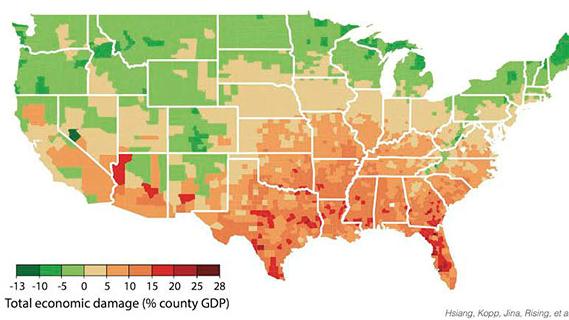Global warming will increase poverty in the southern US, a new study says
This is the Climate Impact Lab prediction of economic damage from global warming, by US county.
A new study estimates that southern areas of the US, many of which are already poor, could face a 20 percent decline in economic activity if carbon emissions continue unabated through the 21st century.
The study was issued by economists with the Climate Impact Lab, a consortium of experts from the Universities of California, Chicago and Rutgers and the Rhodium Group.
“We found that the southern United States, the southern parts of the Midwest and also the Atlantic coast are some of the most hardest-hit parts of the country,” says Solomon Hsiang, a public policy professor at the University of California, Berkeley, and one of the study's lead researchers.
“There was a pretty good explanation for that, once we did the analysis and we understood [what] was going on,” he explains. “The economic impact of warming is much worse if you are already pretty hot. So, going from 90 to 95 degrees is a much bigger deal than going from 70 to 75 degrees. Because the southern parts of the country are already so warm, a bit of warming does a lot more harm to them than to the northern parts of the country that tend to be cooler.”
In some cases, places along the North could even benefit from climate change, Hsiang says. “This is an important finding because the northern parts of the country tend to be wealthier today, and the southern parts of the country tend to be poorer. By hurting the South more, you're really hurting the poor population in the country relatively more, and this, we think, means inequality within the country could actually worsen.”
A 10 to 20 percent loss in economic activity is a lot, Hsiang stresses. “It’s actually worse than what was experienced during the Great Recession in the United States, and it's not that different from what parts of the Midwest experienced during the Dust Bowl.”
Texas, Florida and Louisiana could be particularly hard hit, Hsiang notes, due to the combination of rising temperatures and increasingly severe storms.
“As sea level rises, storms are going to have bigger surges," he explains. “In the future, we expect to have a changing pattern of hurricanes, where sometimes there will be more of them and sometimes they will be stronger. So, that can increase the economic losses year-over-year quite substantially.”
Ironically, the regions expected to have the most economic damage from climate disruption are politically conservative strongholds where opposition to the Environmental Protection Agency and the Paris climate agreement runs high. Hsiang emphasizes, however, that their lab’s work began many years ago and is unrelated to the current political situation in the US.
“Nobody knew that this was going to be what we saw in the data,” he says. “But what we're hoping is that now the public can have a well-informed dialogue about how we want to manage the climate, based on what we can see, at least at this point, what might be lying ahead.”
“I think climate change is going to make it a lot harder to meet the standards of living that people expect, particularly in the regions that are hardest hit,” he continues. “One way I put it to some folks is that climate change imposes something that's on a scale sometimes bigger than a recession — except it doesn't go away. It’s not like we just recover from it. Once you have it, it's here to stay.”
“So, we think about whether or not we can make changes today that will avoid those types of outcomes. These are the types of questions we should be asking ourselves,” he concludes.
This article is based on an interview that aired on PRI’s Living on Earth with Steve Curwood.
